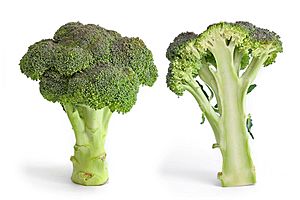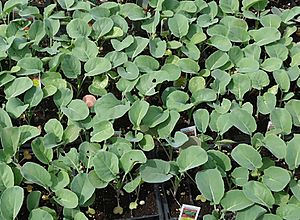Broccoli facts for kids
Quick facts for kids Broccoli |
|
|---|---|
 |
|
| Species | Brassica oleracea |
| Cultivar group | italica |
| Origin | Italy, more than 2,000 years ago |
Broccoli (Brassica oleracea var. italica) is an edible green plant in the cabbage family (family Brassicaceae, genus Brassica) whose large flowering head, stalk and small associated leaves are eaten as a vegetable. Broccoli is classified in the Italica cultivar group of the species Brassica oleracea. Broccoli has large flower heads, usually dark green, arranged in a tree-like structure branching out from a thick stalk which is usually light green. The mass of flower heads is surrounded by leaves. Broccoli resembles cauliflower, which is a different but closely related cultivar group of the same Brassica species.
It is eaten either raw or cooked. Broccoli is a particularly rich source of vitamin C and vitamin K. Contents of its characteristic sulfur-containing glucosinolate compounds, isothiocyanates and sulforaphane, are diminished by boiling but are better preserved by steaming, microwaving or stir-frying.
Rapini, sometimes called "broccoli rabe," is a distinct species from broccoli, forming similar but smaller heads, and is actually a type of turnip (Brassica rapa).
Contents
Etymology
The word broccoli, first used in the 17th century, comes from the Italian plural of broccolo, which means "the flowering crest of a cabbage", and is the diminutive form of brocco, meaning "small nail" or "sprout".
History
Broccoli resulted from breeding of landrace Brassica crops in the northern Mediterranean starting in about the sixth century BC. Broccoli has its origins in primitive cultivars grown in the Roman Empire and was most likely improved via artificial selection in the southern Italian Peninsula or in Sicily. Broccoli was spread to northern Europe by the 18th century and brought to North America in the 19th century by Italian immigrants. After the Second World War, breeding of United States and Japanese F1 hybrids increased yields, quality, growth speed, and regional adaptation, which produced the cultivars that have been the most popular since then: 'Premium Crop', 'Packman', and 'Marathon'.
Other cultivar groups of Brassica oleracea
Other cultivar groups of Brassica oleracea include cabbage (Capitata Group), cauliflower and Romanesco broccoli (Botrytis Group), kale (Acephala Group), collard (Viridis Group), kohlrabi (Gongylodes Group), Brussels sprouts (Gemmifera Group), and kai-lan (Alboglabra Group). As these groups are the same species, they readily hybridize: for example, broccolini or "Tenderstem broccoli" is a cross between broccoli and kai-lan. Broccoli cultivars form the genetic basis of the "tropical cauliflowers" commonly grown in South and Southeastern Asia, although they produce a more cauliflower-like head in warmer conditions.
| Broccoli production — 2019 (includes cauliflower) |
|
|---|---|
| Country | Production millions of tonnes |
| 10.6 | |
| 9.1 | |
| 1.2 | |
| 0.7 | |
| 0.7 | |
| World | 26.9 |
| Source: FAOSTAT of the United Nations | |
Varieties
There are three commonly grown types of broccoli. The most familiar is Calabrese broccoli, often referred to simply as "broccoli", named after Calabria in Italy. It has large (10- to 20-cm) green heads and thick stalks. It is a cool-season annual crop. Sprouting broccoli (white or purple) has a larger number of heads with many thin stalks. Purple cauliflower or violet cauliflower is a type of broccoli grown in Europe and North America. It has a head shaped like cauliflower but consisting of many tiny flower buds. It sometimes, but not always, has a purple cast to the tips of the flower buds. Purple cauliflower may also be white, red, green, or other colors.
Other popular cultivars include Belstar, Blue Wind, Coronado Crown, Destiny, DiCicco, Green Goliath, Green Magic, Purple Sprouting, Romanesco, Sun King and Waltham 29.
Beneforté is a variety of broccoli containing 2–3 times more glucoraphanin and produced by crossing broccoli with a wild Brassica variety, Brassica oleracea var villosa.
Cultivation
The majority of broccoli cultivars are cool-weather crops that do poorly in hot summer weather. Broccoli grows best when exposed to an average daily temperature between 18 and 23 °C (64 and 73 °F). When the cluster of flowers, also referred to as a "head" of broccoli, appear in the center of the plant, the cluster is generally green. Garden pruners or shears are used to cut the head about 25 mm (1 in) from the tip. Broccoli should be harvested before the flowers on the head bloom bright yellow.
| Nutritional value per 100 g (3.5 oz) | |
|---|---|
| Energy | 141 kJ (34 kcal) |
|
6.64 g
|
|
| Sugars | 1.7 g |
| Dietary fiber | 2.6 g |
|
0.37 g
|
|
|
Protein
|
2.82 g
|
| Vitamins | Quantity
%DV†
|
| Vitamin A equiv.
beta-Carotene
lutein zeaxanthin
|
4%
31 μg
3%
361 μg1403 μg
|
| Thiamine (B1) |
6%
0.071 mg |
| Riboflavin (B2) |
10%
0.117 mg |
| Niacin (B3) |
4%
0.639 mg |
| Pantothenic acid (B5) |
11%
0.573 mg |
| Vitamin B6 |
13%
0.175 mg |
| Folate (B9) |
16%
63 μg |
| Choline |
4%
19 mg |
| Vitamin C |
107%
89.2 mg |
| Vitamin E |
5%
0.78 mg |
| Vitamin K |
97%
101.6 μg |
| Minerals | Quantity
%DV†
|
| Calcium |
5%
47 mg |
| Iron |
6%
0.73 mg |
| Magnesium |
6%
21 mg |
| Manganese |
10%
0.21 mg |
| Phosphorus |
9%
66 mg |
| Potassium |
11%
316 mg |
| Sodium |
2%
33 mg |
| Zinc |
4%
0.41 mg |
| Other constituents | Quantity |
| Water | 89.3 g |
|
Link to USDA Database entry
|
|
| †Percentages estimated using US recommendations for adults. | |
Production
In 2019, global production of broccoli (combined for production reports with cauliflowers) was 27 million tonnes, with China and India together accounting for 73% of the world total. Secondary producers, each having about one million tonnes or less annually, were the United States, Spain, and Mexico.
In the United States, broccoli is grown year-round in California – which produced 92% of the crop nationally – with 95% of the total crop produced for fresh sales in 2018.
Broccoli cannot be harvested using machines, meaning it must be hand-harvested.
Nutrition
A 100-gram reference serving of raw broccoli provides 34 calories and is a rich source (20% or higher of the Daily Value, DV) of vitamin C (107% DV) and vitamin K (97% DV) (table). Raw broccoli also contains moderate amounts (10–19% DV) of several B vitamins and the dietary mineral manganese, whereas other micronutrients are low in content (less than 10% DV). Raw broccoli is 89% water, 7% carbohydrates, 3% protein, and contains negligible fat (table).
Cooking
Boiling substantially reduces the levels of broccoli glucosinolates, while other cooking methods, such as steaming, microwaving, and stir-frying, have no significant effect on glucosinolate levels.
Taste
Broccoli may taste bitter. That's because it contains glucosinolates. Also, research indicates that bitter taste perception in broccoli is genetically inherited through the gene TAS2R38.
Pests
Mostly introduced by accident to North America, Australia and New Zealand, "cabbage worms", the larvae of Pieris rapae, also known as the "small white" butterfly, are a common pest in broccoli.
Additional pests common to broccoli production include:
- Aphids
- Cabbage looper
- Cabbage webworm
- Cross-striped cabbageworm
- Diamondback moth
- Imported cabbageworm
- Cabbage maggot
- Harlequin cabbage bug
Gallery
-
Furrow flood irrigation on a field of broccoli raised for seed in Yuma, Arizona.
See also
 In Spanish: Brócoli para niños
In Spanish: Brócoli para niños







